
LinkedIn is the social hub for business professionals. But it’s not the best fit for every brand’s marketing strategy. This article will provide an exploration of the strategic benefits of deploying an organic strategy, as well as some of the drawbacks. It will also provide a tactical implementation plan should you choose to add organic LinkedIn to your high-level lead generation program.
Creating and sharing content on LinkedIn can be part of your company’s digital marketing strategy, but it’s important to follow best practices to get the most return on the time and effort you spend on this platform. Below are some tips and tricks to get you started.
Beef up your LinkedIn page
Many conversions on LinkedIn actually stem from company page visits, so you don’t want to miss out on those.
Key areas to focus on include:
- Company description. This is the first thing a prospect will read when they land on your company page.
- This is especially important if you serve a localized market.
- Up to three hashtags can be added to your profile to enhance your searchability by industry and offering.
- Custom button selection. This is your primary CTA, so ensure that it’s driving traffic to your desired destination, be that your website, a contact us page, a signup page, or otherwise.
Engage With Other People in Your Niche
When you look at social media from a business perspective, it’s easy to think of it purely in terms of marketing. Your audience is spending time on LinkedIn, so you want to reach them, engage them, and bring them to your website.
The marketing aspect of social media is huge, but it’s not the only part of it. It’s also about the social side of building connections and sharing knowledge. You can’t do the marketing part without the social part, particularly when it comes to organic reach.
To grow your organic LinkedIn reach you’ve got to engage with other people in your niche and build real connections. If you can connect with people in your industry, and showcase the value your content offers, then they’re likely to share it with their audience, further expanding your reach.
The search tool in LinkedIn is a great way to discover new people in business. Simply search for your keywords and use the tabs at the top to filter between people, companies, groups, posts, and other useful options.
Optimize for Keywords
A strong organic LinkedIn strategy gets your profile to rank for relevant searches. Linked profile is an opportunity to optimize keywords and phrases so the right people can find you.
You don’t want to overdo it with keywords, but areas like the professional headline and about section are great for including a few of the keywords to have a better chance of showing up in relevant searches.
Get to Know the LinkedIn Algorithm
The goal of the LinkedIn algorithm is to deliver the most relevant content to each user’s newsfeed. LinkedIn wants to keep traffic on their website and stop irrelevant or low-quality content from showing on newsfeeds.
To do this, LinkedIn’s algorithm looks at clicks, likes, comments and shares, and fills newsfeeds with content that seems most relevant to the actions a user takes on the platform. Knowing this can help you create and share relevant and helpful content that will encourage interactions like those listed above. You can use LinkedIn as a place to position your company as a go-to source of information and solutions for both current and potential customers.
Think about who you are trying to reach or influence on LinkedIn as well as your business goals for being on the platform in the first place. Are you trying to collect sales leads? Do you want to increase your influence as a thought leader in your industry? Or are you trying to share your company culture to help find new hires?
Create a LinkedIn content marketing strategy around what your target audience would find most valuable and post content that will help you reach your company’s goals for being on the platform.
Do some hashtag research
LinkedIn users are increasingly using hashtags to help them search for relevant content on the platform. That means that there are two reasons for you to do some hashtag research. Firstly, so that you engage in the conversation on relevant topics/hashtags. Secondly, so that you can use those hashtags in your posts to drive new traffic organically and spark conversations.
Here’s what you need to do to:
- Add a tab/section to your existing spreadsheet/document
- Start searching hashtags based on your industry category, SEO/PPC targets, competitors, and buyer characteristics (ex. #marketing if you’re an ad agency, #leadgeneration if that’s a service you offer, #hubspot if that’s a competitor, or #restaurantproblems if that’s a market that you serve).
- Follow relevant hashtags so you can use your personal account to interact and engage with the people and the businesses that are using them.
- Use LinkedIn to get additional hashtag suggestions. On your personal account homepage, you will want to navigate to your left sidebar. On the bottom of this sidebar is a “Discover more” button which will provide you with suggestions on new people to connect with and new hashtags to follow based on your account behaviour.
- Organize your hashtags based on the ones that you’re following, as well as the categories listed in step 2, and get ready to start using them in posts.
Have questions? Let us know! We’re happy to help.

